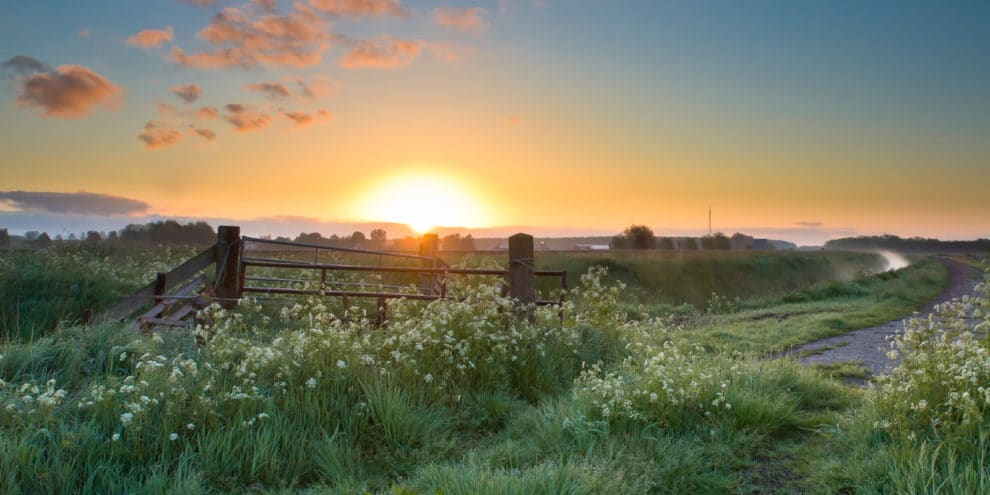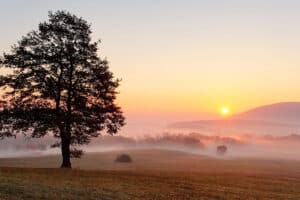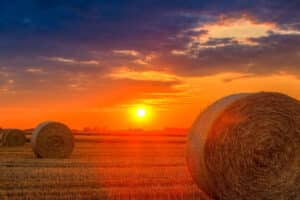Two real-estate-investing strategies — buy and hold, and buy low; sell high — have worked well for many different types of investors in different types of markets over many years.
Of the two, buy and hold is the simpler and likely to be the more profitable for investors in most types of rural land for sale, particularly low-maintenance tracts like open land and timberland. Buy and hold simply requires the investor to retain ownership for a long period of time, doing whatever maintenance is necessary. Time is the critical appreciation factor—more time held, more profit.
With buy low; sell high, the investor has to exercise judgment about when to buy and when to sell—both tricky calls. Is 2010, for example, a buy-low opportunity of timberland for sale, or is it still overpriced? If you think it’s overpriced today, do you think timberland prices will come down during the next five years? If you don’t think they will fall, is timberland still overpriced for what it is, for its intrinsic timber-producing value? If you think it’s overpriced, is now a good time to sell…or should you wait longer? All of these questions raise complications that make answers harder and dependent on local factors.
Fortunately, if you hold land long enough, mistakes in judging when the price was low and when to sell tend to get corrected. At least, that’s been the historical pattern. The only question with buy and hold has been, How long should I hold? There’s no single answer, but 15 to 20 years generally turned an even above-market-price purchase into a healthy profit. A longer hold, more profit.
One other common advantage with buy and hold is to package the long-held land into the tax-free portion of your estate, thus avoiding the hit on long-term capital gains.
One of the basic books on buy-and-hold real estate is, David Schumacher and Steve Dexter’s, Buy and Hold Forever: How to Build Wealth for the 21st Century (2010). The late Schumacher wrote The Buy & Hold Real Estate Strategy and Buy & Hold: 7 Steps to a Real Estate Fortune. Dexter updated and added his own perspectives to the current volume.
These books describe their investing strategy, primarily in near-to-the-beach real estate in Southern California since the 1960s. They seek to identify a property’s growth potential by isolating the larger contextual factors — such as family income, population growth and the projected longevity of that growth — that will drive overall future real-estate appreciation. They concentrate on established neighborhoods.
The business of forecasting economic growth and property trends in a particular town is subject to the caveats inherent in all modeling—with some others thrown in. Schumacher and Dexter simplify modeling to the following rule: “The best way to project what a property is going to be worth 20 years from now is to find an area that had similar characteristics 20 years previously and research what happened to it from the standpoint of growth.”
They go on to say that “…there is no way to make an exact forecast. The only thing you can be assured of is that if you buy in an area with growth potential, there will continue to be increases in land values because growth in a capitalistic economy cannot exist without inflation. …the overall trend inevitably will be up.”
Both of these insights can be applied by even novice investors with some sense of confidence.
Nonetheless, each assumes a rising trend line for the U.S. national economy and a similar trend line from properties within high-growth-potential neighborhoods. They both assume a sustained political, economic and financial stability that could be problematic. It may be that Hermosa Beach and Southern California as a whole will not be replicated as often and as readily as we once thought. I think it was easier to make assumptions about rising trend lines and growth within stability during the last 60 years than it will be for the next 60.
With those systemic reservations in mind, I think it’s a great deal easier to apply buy and hold to rural property than to metropolitan properties where neighborhoods can change unpredictably over time. The value of rural property can certainly be changed by unforeseen factors, both positively and negatively, but my sense is these changes generally take place more slowly than in metro areas. Investors have more time to respond to slower changes.
Absent an unprecedented deflation, an investor with a 20-year-plus horizon is likely to be both safe and profitable with rural real estate, illustrated by the examples below:
- cropland that is not irrigation-dependent;
- good, but less than prime, farmland in the Midwest, particularly land that can be upgraded through better management;
- farmland that can be used to produce diverse crops, not just one;
- pasture that can be adapted to rotational grazing;
- tracts that can be converted to organic or semi-organic farming and are convenient to a university/college town or small city;
- lots under 20 acres that are in small communities with diverse economies with growing population and family incomes;
- small tracts that are currently just outside the HBU influence of wealthy enclaves;
- land that is beyond the current ring of metropolitan HBU influence (because population-driven HBU valuations will keep extending outward);
- hardwood timber tracts that have not been high-graded too badly or recently;
- planted pine that hasn’t been thinned yet on a 20-to-30 year rotation;
- marginal farmland that might be planted to a short-rotation tree;
- property whose assets are divisible, with a core that’s a keeper;
- tracts who uses are not likely to be constrained by the presence of ETS-species habitat or restrictive clean-water and wetlands rules; and
- tracts that are not permanently and negatively discounted by environmental misuses, such as unusable reclaimed surface mines.
Others in the land business can add/subtract to this initial list, and customize selections to fit local conditions. These types of purchases are good candidates for rural buy-and-hold investors.
This content may not be used or reproduced in any manner whatsoever, in part or in whole, without written permission of LANDTHINK. Use of this content without permission is a violation of federal copyright law. The articles, posts, comments, opinions and information provided by LANDTHINK are for informational and research purposes only and DOES NOT substitute or coincide with the advice of an attorney, accountant, real estate broker or any other licensed real estate professional. LANDTHINK strongly advises visitors and readers to seek their own professional guidance and advice related to buying, investing in or selling real estate.










Good article. Please keep acronyms to a minimum so that all readers can understand the articles. HBU and ETS should be defined in the above article.
HBU means Higher and Better Use. It refers to land that has the potential to be used for a different, higher-value purpose other than that which it was being used for at the time of purchase. The purchase price was lower; the HBU reclassification bumps up the price. Typically, a large tract of timberland might be bought at $1,000/a as a timber-producing asset and resold in small parcels as second-home lots for, say, $4,000/a. The second-home reclassification is considered the HBU value.
ETS refers to Endangered, Threatened and Sensitive species under federal law.
Isn’t buying and holding real estate nothing more then speculation? I watched a lot of people lose their shirts in the last 10 years buying on speculation. I would feel better if I could cash flow the land and service the debt while holding for long term gains some how.
Curtis
Great Post; I agree and Very informative and a good Reminder for that Savvy Land Buyer.
Great to see somebody who looks at all sides of the land as a holding issue.
I’ve worked with clients for years (15) and can recall only one case where the buyer didn’t have a return on his investment.
Keep up the great articles. Buying and selling is speculation as is every other investment, however, there is much less risk in land buying than any other investing that I know of.
I advise against speculating, which is different from investing. The latter makes certain assumptions about the future, such as the United States will continue to be a country/economy that more or less protects property rights, contract rights and grows. Beyond that, investing is about stripping risk from putting money into an asset.
Your friends lost money because they were speculating. They were not in for the long-term. They bought too high for the intrinsic value of the property. They were probably overleveraged.
I’ve never known a genuine land investor following buy and hold for the long-term not make a significant gain.
I’m sure there are some who have, however.
Curtis
Thanks for the responses.. I love land and feel that it’s a great investment. I’ve been buying small lots in a few different states and reselling them with seller financing. I really look forward to learning more..
Opportunity costs did not seem to be included in your analysis. That is a major factor in long term true returns. The turnover of your investment capital is critical in determining actual return on investment. Agricultural land has notoriously returned 4 to 5 percent per year including inflation, which is good, and I believe in land as a solid investment, but not for the “high” return but the solid and safe return.
Frank,
Could you explain what you mean by opportunity costs?
I am not familiar with that term.
The idea of opportunity costs is, of course, a fair point to raise with respect to all investments. Opportunity costs represent the estimated net gain that would have been accumulated by investing a dollar in a very safe instrument (like a savings account) rather than the alternative investment you chose, in this case land of one type or another.
Most analyses of returns to not factor in opportunity costs. But if they were they would generally be a discount factor.
When figuring opportunity costs, you also have to consider the tax consequences of the safe investment as well as the effect of inflation. These are complicated calculations, because you’re dealing with a lot of unknowns that get mashed together under the labels of assumptions and scenarios.
But Frank’s point is correct.
And while you’re at it, you also need to think about the cost/gain of doing nothing with your money. Inflation will erode it, but in a high-risk environment, that may be an acceptable path.
Could you explain your comment on marginal farmland which could be planted in a short rotation tree?
I have 300 acres of deep east Texas river bottom land that I recently inherited (no environmental restrictions yet) with a hardwood stand that’s been high graded. I’ve been investigating cold tolerant eucalypts, but market introduction progress appears to be slow and the Paper Industry appears in a steep secular decline.
Any suggestions on making this tract more valuable? By the way, I’ve just purchased you “Dirt Smart” Book and it’s very informative.
I am new at this looking for land ( a novice actually) but was curious as to why so many large acre parcels on this site does not offer partial purchases (subdivide) for those who may only need 5 or so acres?
And if you find there is wetland on a property is it still okay to purchase it if you want to build a home on it?
Thank you for your answer
Great article, also a newbie, at 46 I am curious to look for land to purchase and later have a log home built on it suitable for retirement in 20 -> 25 years. I may be wrong on this, but thinking of buying land for this purpose by 50 to 55, and hope to have it paid off prior to retirement. Having no other advise, I found this page in a general search.
Brian O’Neill
Interesting. I also have small pieces of inherited land. Is there even anywhere to sell those parcels in 2010? It seems difficult to find investors who want to buy and hold.
I saw the following sentence in the above article…”One other common advantage with buy and hold is to package the long-held land into the tax-free portion of your estate, thus avoiding the hit on long-term capital gains.”
How does one go about packaging your acreage into your tax-free portion of your estate? Could someone explain this to me?
Thanks.
I can explain how to buy in your estate. 303 883 7080
Ryan,
Sorry I didn’t get back to you. I’m still pretty curious on how to move these small parcels.